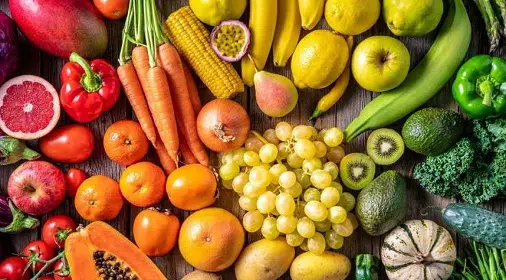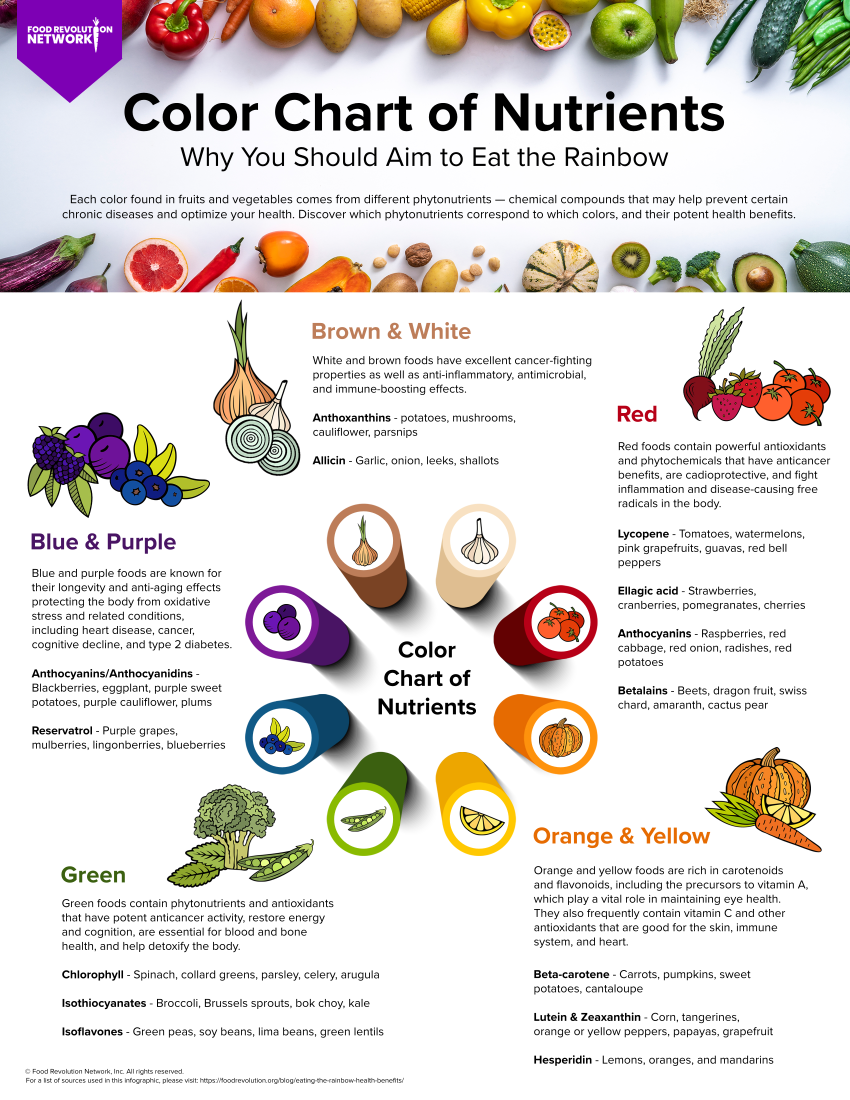by Ocean Robbins: “Eat the rainbow” is a fundamental healthy eating tip. (And no, we don’t mean artificially colored foods like Skittles or M&Ms!)…
But what does it mean? Why is it important to get a variety of colorful fruits and vegetables in your diet?
You may be tempted to find a few foods you or your kids or family members like and focus on eating those. And it can be easy to fall into routines. But the truth is: Our bodies thrive on variety — a rainbow of nutrients.
In fact, the variety of vitamins, minerals, antioxidants, and phytochemicals in fruits and vegetables may be more powerful for your health than any pill.
Eating a diversity of colorful foods can be an easy way to get the complete range of nutrients your body needs to thrive.
Eating the Rainbow Is Important for Everyone — Kids and Adults!
A varied, balanced diet gives your body the nutrition it needs to work properly. And without good nutrition, your body will be more likely to suffer from disease, illness, and poor performance.
Advice to eat the rainbow is often used with kids. And while kids especially need a diversity of foods in their diets, so do adults.
Why Are Fruits and Vegetables Full of so Many Colors?
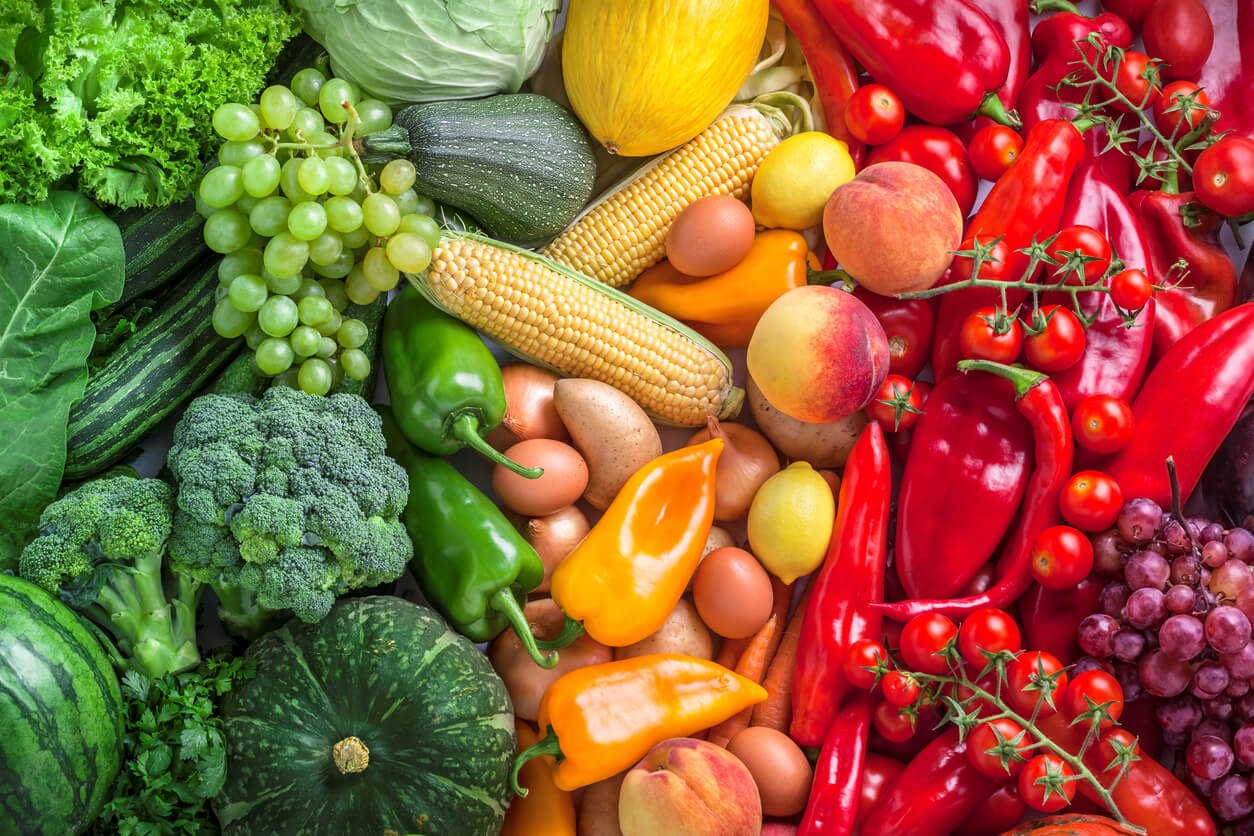
Each color in fruits and vegetables is created by specific phytonutrients, which are natural compounds that help protect plants from germs, bugs, the sun, and other threats.
And each color indicates an abundance of specific nutrients.
Phytonutrients aren’t essential to keep you alive (unlike vitamins and minerals). But they may help prevent certain lifestyle diseases and keep your body working as it should.
Most Americans Aren’t Getting the Range of Colorful Foods They Need
A 2015 Morbidity and Mortality Weekly Report from the CDC states that “the percentage of the adult population meeting fruit and vegetable intake recommendation is low. In 2013, 13.1% of respondents met fruit intake recommendations and 8.9% met vegetable recommendations.”
And, according to an older 2009 report about phytonutrients, 8 out of 10 people in the US are falling short in virtually every color category of phytonutrients.
Based on the report:
- 69% of Americans are falling short in green phytonutrients
- 78% of Americans are falling short in red phytonutrients
- 86% of Americans are falling short in white phytonutrients
- 88% of Americans are falling short in purple and blue phytonutrients
- 79% of Americans are falling short in yellow and orange phytonutrients
Now, let’s take a look at what the color of your food can tell you about its nutrition. And how you can get more of a colorful range of phytonutrients to help your body function at its best. After exploring all the different colors and their corresponding foods and phytochemicals, stick around for a helpful rainbow food chart that you can share or print at home.
Healthy Red Foods Help Fight Cancer, Reduce the Risk of Diabetes and Heart Disease, Improve Skin Quality, and More
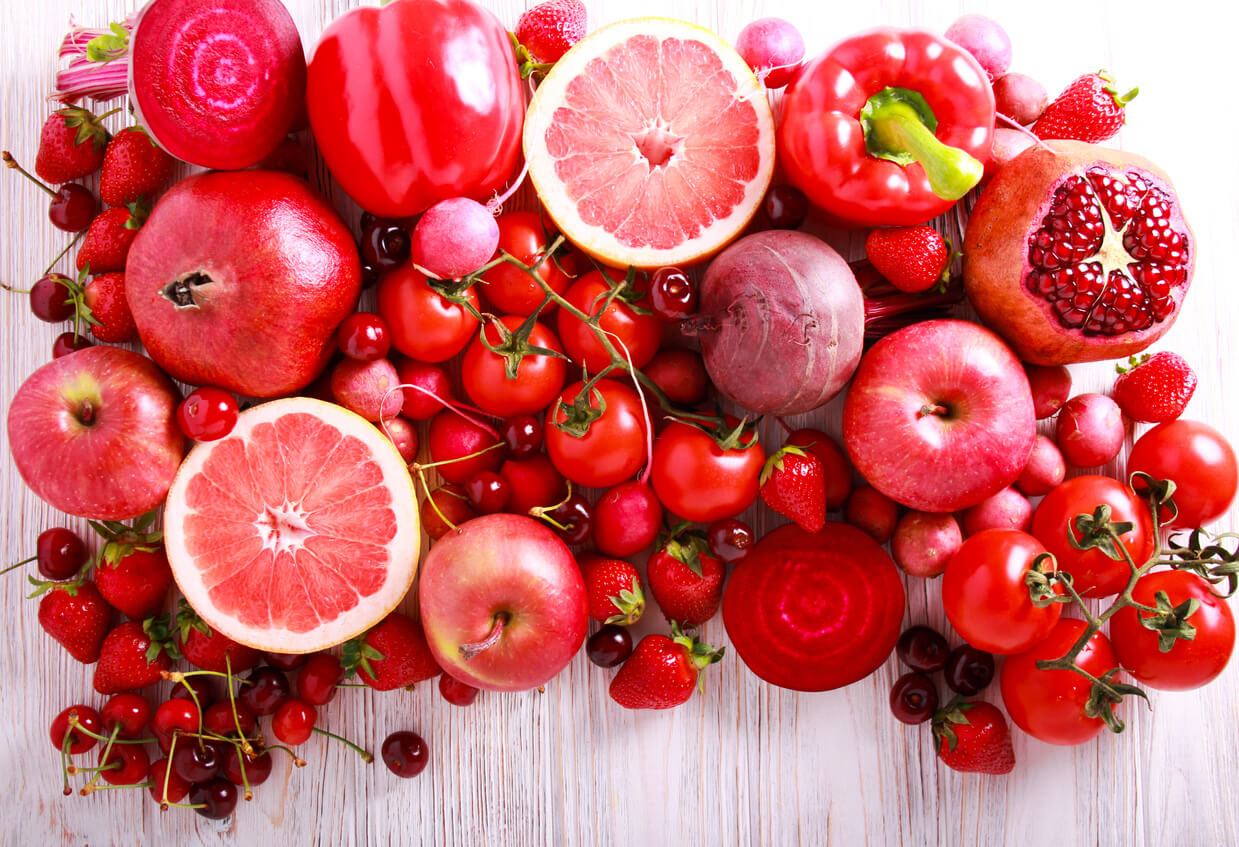
Red fruits and vegetables contain phytochemicals including lycopene and ellagic acid. These powerful nutrients have been studied for their cancer-fighting effects and other health benefits.
For example, regular consumption of tomatoes and tomato products (like cooked tomatoes and tomato sauce) has been shown to reduce the risk for prostate cancer. Watermelon is even higher in lycopene than tomatoes, and the lycopene may be more bioavailable, too.
Watermelon is also rich in a phytonutrient called citrulline, which may work as a treatment for mild to moderate erectile dysfunction.
And red vegetables, like beets, have been shown to affect the nitric oxide pathway, helping blood vessels dilate. This improves circulation and helps reduce the risk of heart disease.
Also, strawberries have been found to prevent and even reverse the progression of esophageal cancer. Berries, in general, are rich in bioactive compounds that protect against chronic diseases like heart disease and Alzheimer’s.
Getting your phytonutrients from whole foods is best. In fact, some studies show that taking phytonutrients, like lycopene and beta-carotene, in supplement form may actually increase the risk of cancer. But consuming these phytonutrients in whole food form, like tomato sauce, may help decrease the risk of cancer.
There’s plenty of evidence that eating an abundance of colorful fruits and vegetables offers protective effects for heart health, and may even help lengthen your lifespan.
Your skin benefits from eating red foods, too. The polyphenols and antioxidants in red fruits and veggies may help prevent skin cancer and offer skin protection against damaging effects from sunlight, excessive inflammation, and wounds.
Examples of Healthy Red Foods to Try
- Red peppers
- Tomatoes
- Strawberries
- Raspberries
- Watermelon
- Apples
- Cranberries
- Kidney beans
- Cherries
- Grapes
- Red onions
- Pomegranate
- Beets
Yellow and Orange Fruits and Vegetables Improve Immune Function, Reduce the Risk of Heart Disease, Promote Eye Health, and More
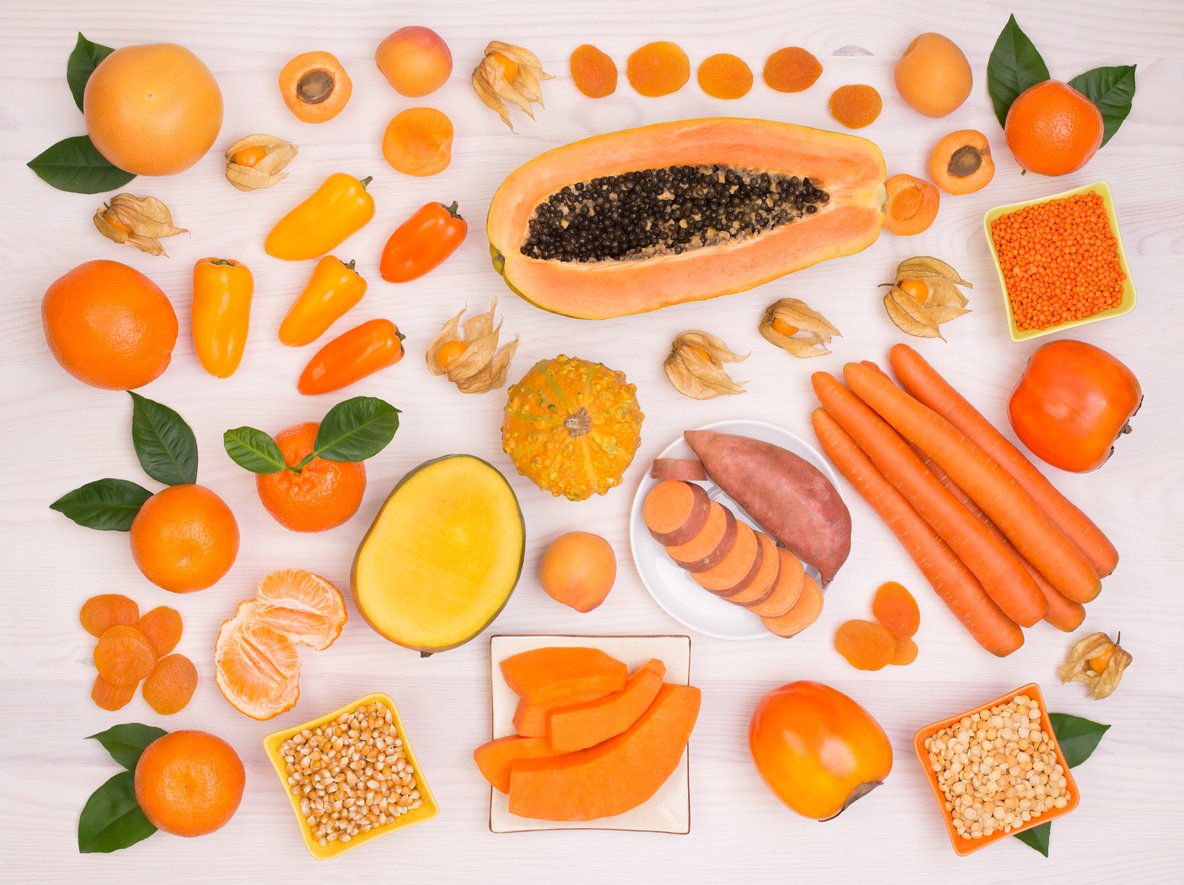
Orange and yellow fruits and vegetables are rich in vitamin C and carotenoids, including beta-carotene. Some carotenoids, most notably beta-carotene, convert to vitamin A within the body, which helps promote healthy vision and cell growth.
Citrus fruits, like oranges, contain a unique phytonutrient called hesperidin, which helps to increase blood flow. This has important health ramifications. If you tend to get cold hands and feet, eating an orange a day may help to keep your hands and feet warm. Even more importantly, consuming citrus may also reduce your risk of stroke.
Two of the most notable carotenoids in orange and yellow foods are lutein and zeaxanthin. These fat-soluble antioxidants have been heavily studied for their ability to help protect the health of your eyes. In fact, they accumulate in the retina of your eyes, where they help prevent cataracts and diseases like age-related macular degeneration — the leading cause of blindness around the world. They also protect your eyes from damage caused by blue light emitted from phone, computer, and television screens.
Examples of Healthy Orange and Yellow Foods to Try
- Oranges
- Grapefruit
- Lemons
- Mangoes
- Papayas
- Carrots
- Sweet potatoes
- Winter squash (butternut, kabocha, delicata, acorn)
- Yellow summer squash
- Corn
- Cantaloupe
- Orange and yellow peppers
- Golden beets
- Pineapple
- Peaches
- Bananas
Green Fruits and Vegetables Boost the Immune System, Help Detoxify the Body, Restore Energy and Vitality, and More
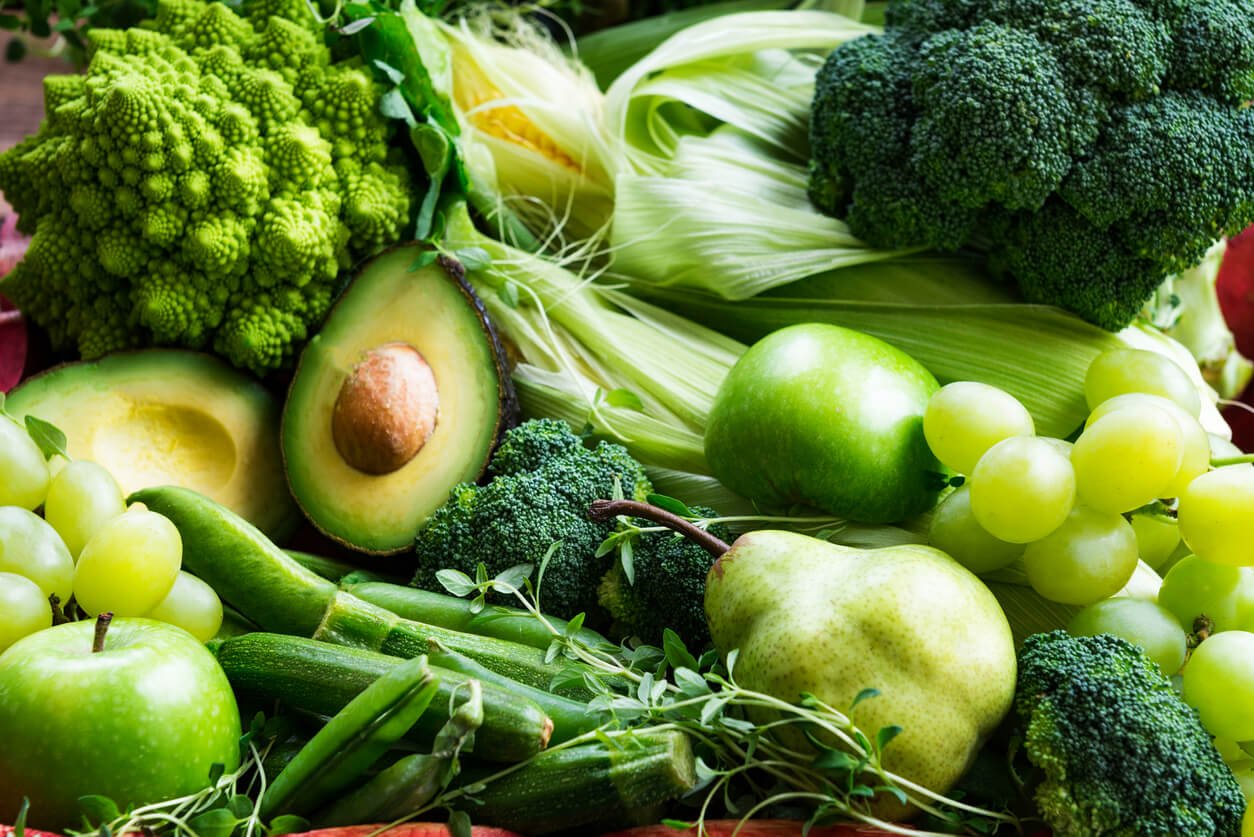
Greens are some of the healthiest foods we can eat. Green fruits and vegetables are rich in lutein, isothiocyanates, isoflavones, and vitamin K — which is essential for blood and bone health.
Green vegetables are also rich in folate — a nutrient especially important for pregnant women to consume to help prevent congenital disabilities.
Cruciferous vegetables, like broccoli and cabbage, have been shown to enhance immune function, while dark leafy greens like kale may improve mood.
Research has even shown that eating leafy greens is associated with a slower rate of cognitive decline. One study among 960 participants aged 58–99 years old found that those who consumed at least 1.3 servings per day of leafy greens for nearly five years experienced cognitive improvement likened to being 11 years younger in age, compared to those who consumed fewer greens.
Greens are also a highly bioavailable source of calcium and vitamin K1, which have a positive impact on bone metabolism.
And kiwi fruit has been shown to help alleviate a wide array of maladies, from the common cold to IBS to insomnia, and it may even help repair DNA damage.
Examples of Healthy Green Foods to Try
- Broccoli
- Kale
- Romaine lettuce
- Collard greens
- Brussels sprouts
- Green cabbage
- Green grapes
- Asparagus
- Spinach
- Swiss chard
- Arugula
- Green beans
- Peas
- Zucchini
- Kiwi fruit
- Avocado
- Green apples
- Edamame
Purple and Blue Fruits and Vegetables May Reduce the Risk of Cancer and Heart Disease, Support Cognition, Decrease Inflammation, and Improve Skin Health
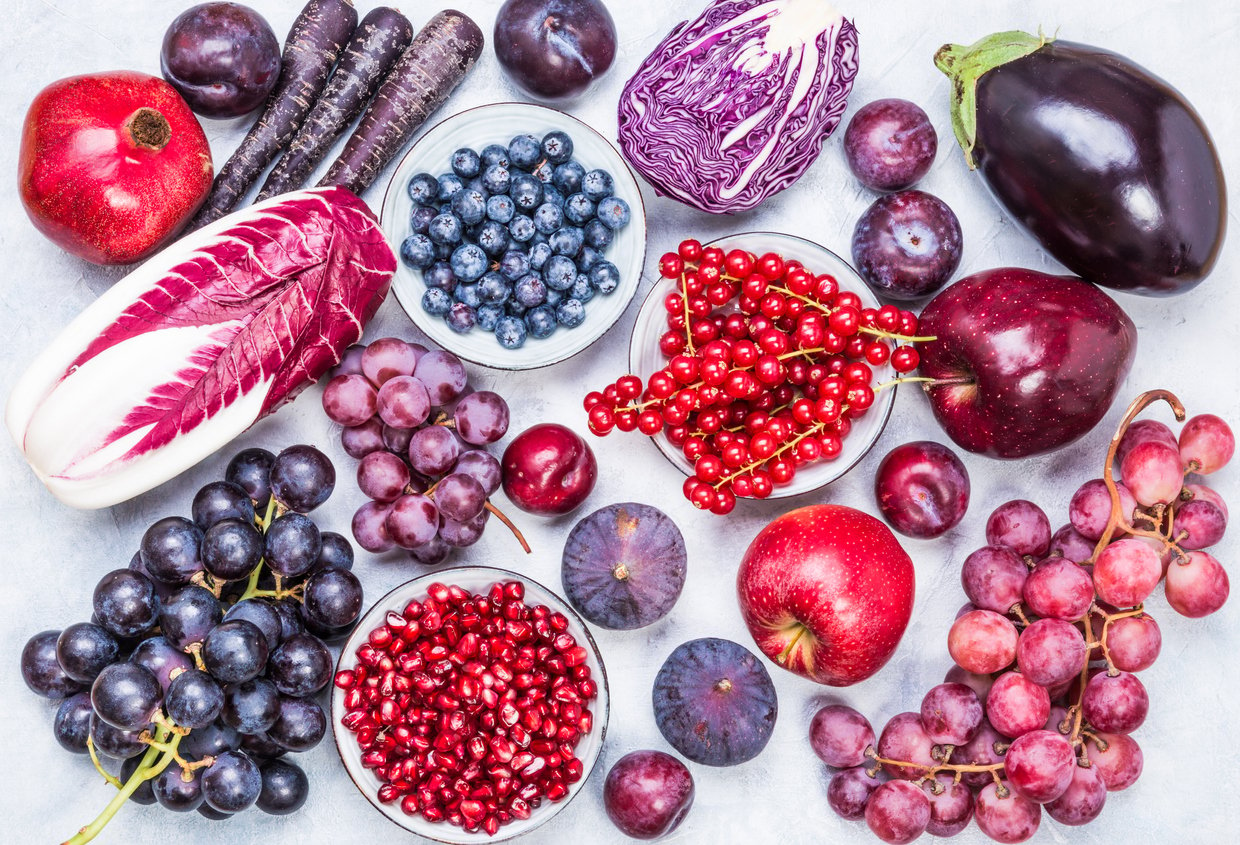
Blue and purple fruits and vegetables are rich in anthocyanins and resveratrol and have been studied extensively for their anticancer and antiaging properties.
Studies show that the bioactive phytochemicals in berries work to repair damage from oxidative stress and inflammation.
The anthocyanins in blueberries and red grapes may help reduce the risk for heart disease, cognitive decline, and type 2 diabetes, as well as support healthy weight maintenance and a normal inflammatory response.
Red grapes are also full of polyphenol compounds and antioxidants. One of these is resveratrol, which has been associated with increased nitric oxide production and better heart health outcomes.
And red cabbage, which is really more of a purple color, is one of the best superfood bargains and has the highest level of antioxidants per dollar.
Blue and Purple Fruits and Veggies to Try
- Blueberries
- Blackberries
- Red (purple) grapes
- Red (purple) cabbage
- Plums
- Prunes
- Red (purple) onions
- Eggplant
- Purple potatoes and sweet potatoes
- Purple cauliflower
- Figs
- Raisins
Brown and White Colored Foods Protect Against Certain Cancers, Keep Bones Strong, and Are a Heart-Healthy Choice
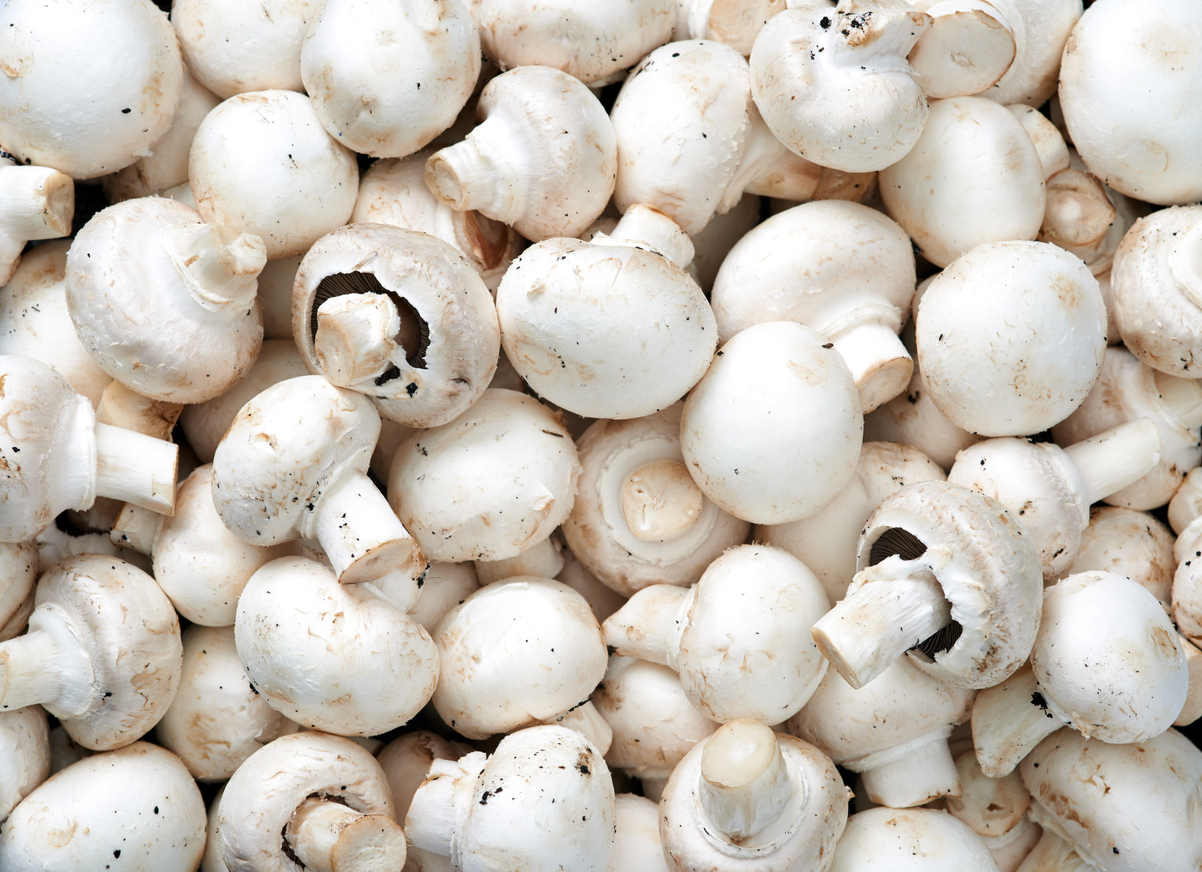
Though they aren’t as brightly colored as other foods, white and brown produce are still great healthy choices.
Like broccoli, cauliflower is a cruciferous vegetable rich in an anticancer compound called sulforaphane.
Garlic and onions are in the allium family of vegetables and contain the powerful health-promoting compounds allicin and quercetin. Aged garlic has been shown to have anti-inflammatory, immune-boosting, and anti-allergic effects, even more so than raw garlic.
And phytonutrients in white button mushrooms have been found to inhibit aromatase activity and breast cancer cell proliferation. This common mushroom variety also has antimicrobial activity.
Healthy White and Brown Fruits and Veggies List
- Cauliflower
- Garlic
- Onions
- Mushrooms
- Potatoes
- Parsnips
- Daikon radish
- Jicama
A Visual List of Phytochemicals
Whew! That’s a lot of colorful foods and nutrients to remember. Luckily, we’ve made it easier than ever to get a healthy dose of antioxidants with this rainbow chart of nutrients. In this nutritional infographic, you’ll see what color foods correspond to what phytochemicals, so you can create beautiful and health-fulfilling rainbow meals.
Tips to Help You Eat the Rainbow Every Day
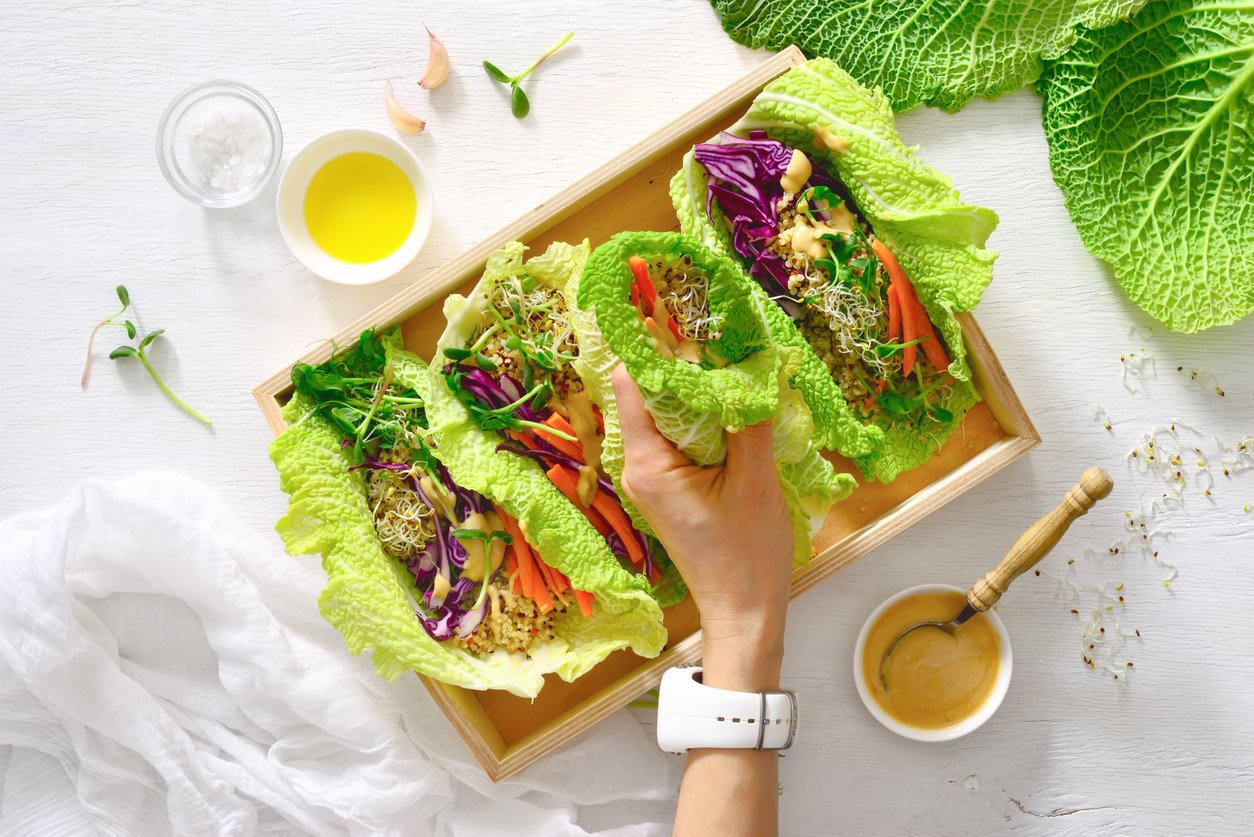
Now you hopefully see why eating a variety of colorful foods is good for your health. But how do you make that happen? Here are some tips you can use when creating your meals:
- Eat a beautiful breakfast. Instead of drab bagels, eggs, or yogurt, start your day with a green smoothie, oatmeal topped with red berries, or a tofu scramble filled with red peppers, mushrooms, carrots, or other colorful veggies.
- Enjoy exciting salads. Large, colorful salads topped with beans and a diverse selection of vegetables are the perfect way to incorporate lots of colorful veggies (and fruits!) into your diet. Eat them for lunch or dinner. And try to have at least one per day.
- Liven up your lunch. Veggie sandwiches and wraps (including lettuce wraps) and soups, stews, and chili can help you get a balanced selection of colorful foods for lunch.
- Make vegetables the main dish. Try new recipes for dishes, such as tempeh vegetable stir-fries, vegetable curries, and Buddha bowls.
- Make a rainbow meal. Try creating a meal that uses every color — red, orange, yellow, green, blue, purple, white, and brown. (If you have kids, they will love this idea.)
Recipe Ideas to Inspire You to Add Color and Variety to Your Meals
Below are several colorful recipes to help you eat the rainbow. In fact, each one of the recipes below includes at least five colors from the rainbow!
Try the Garden Breakfast Wrap for a nourishing savory meal to start your day. Get a burst of flavor with each bite when you enjoy the Rainbow Salad with Carrot Ginger Dressing, which is YUMMY! Let the Quinoa, Bean, and Vegetable Soup (any veggies you have on hand go well here!) comfort and satisfy you. And experience a meal that’s almost too pretty to eat when you make (and eat!) the Thai Peanut Rainbow Noodles. Then blend colorful fruits, veggies, and seeds together to create the beautiful Autumn Sunrise Smoothie (yes, indeed, it looks like a stunning sunrise!). Share your colorful, culinary experience with us!
Garden Breakfast Wrap 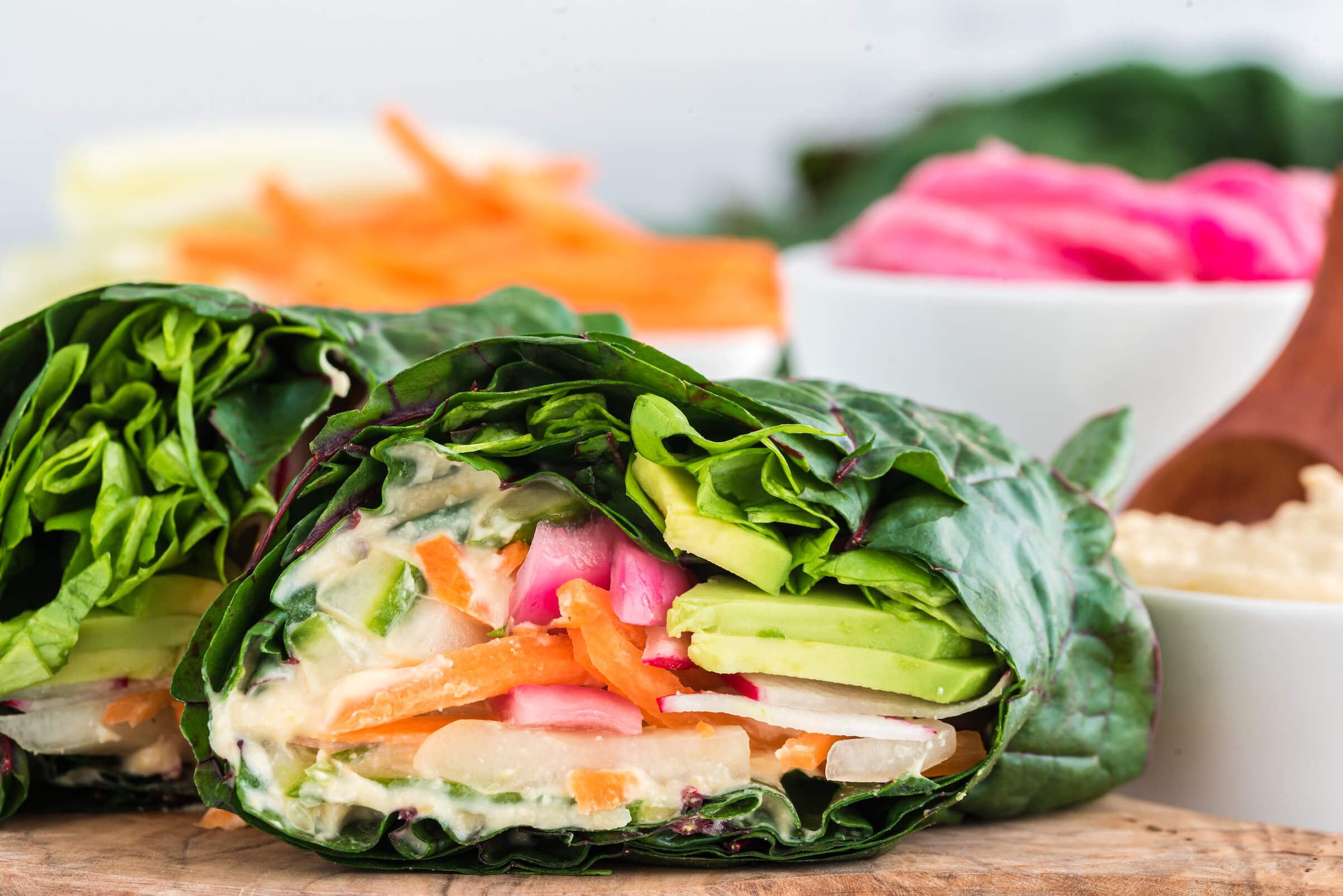
One of the beautiful things about this wrap is that you can use any veggies from your fridge or growing from your garden to make it your own. Beginning the day with leafy greens, like kale, collards, or romaine, is the perfect way to jump-start your morning with nutrition. Once you spread the hummus on your green wrap, start adding your favorite veggies — and get ready for some creamy crunch to stimulate your palate and a variety of nutrients to energize your body!
Rainbow Salad with Carrot Ginger Dressing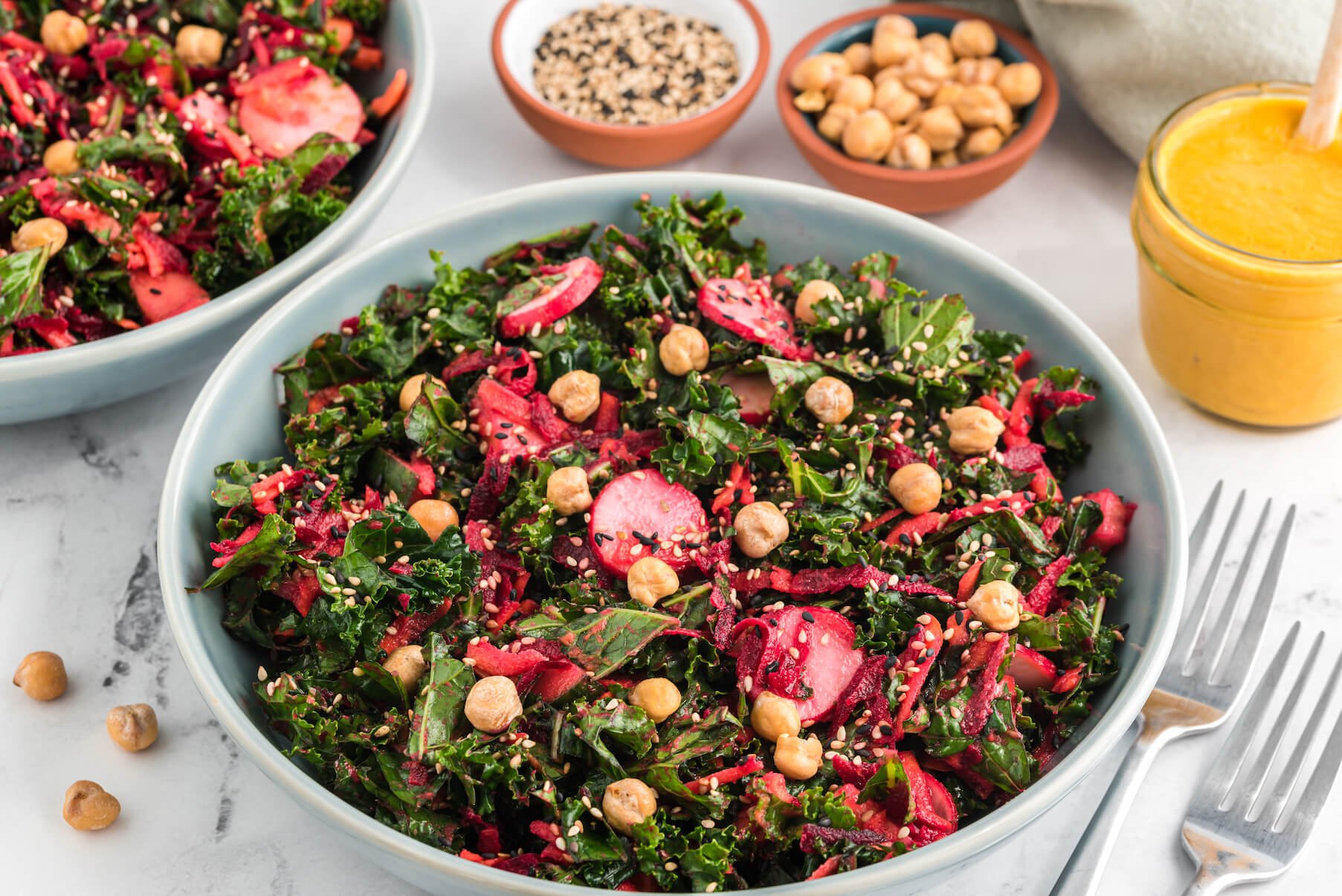
One way to uplevel just about any meal is to add a delicious and nutritious plant-based dressing or sauce. Carrot Ginger Dressing is bursting with flavor while adding healing carotenoids from the carrots, gingerol from the ginger, and prebiotic fiber from the shallots. Not to mention, the dressing is over-the-top scrumptious! Drizzle it over dark leafy greens, like kale, then add all of your favorite colorful veggies like radish, cucumber, beets, and avocado. Or, get creative by using any veggies growing in your backyard or that you need to use from the fridge!
Quinoa, Bean, and Vegetable Soup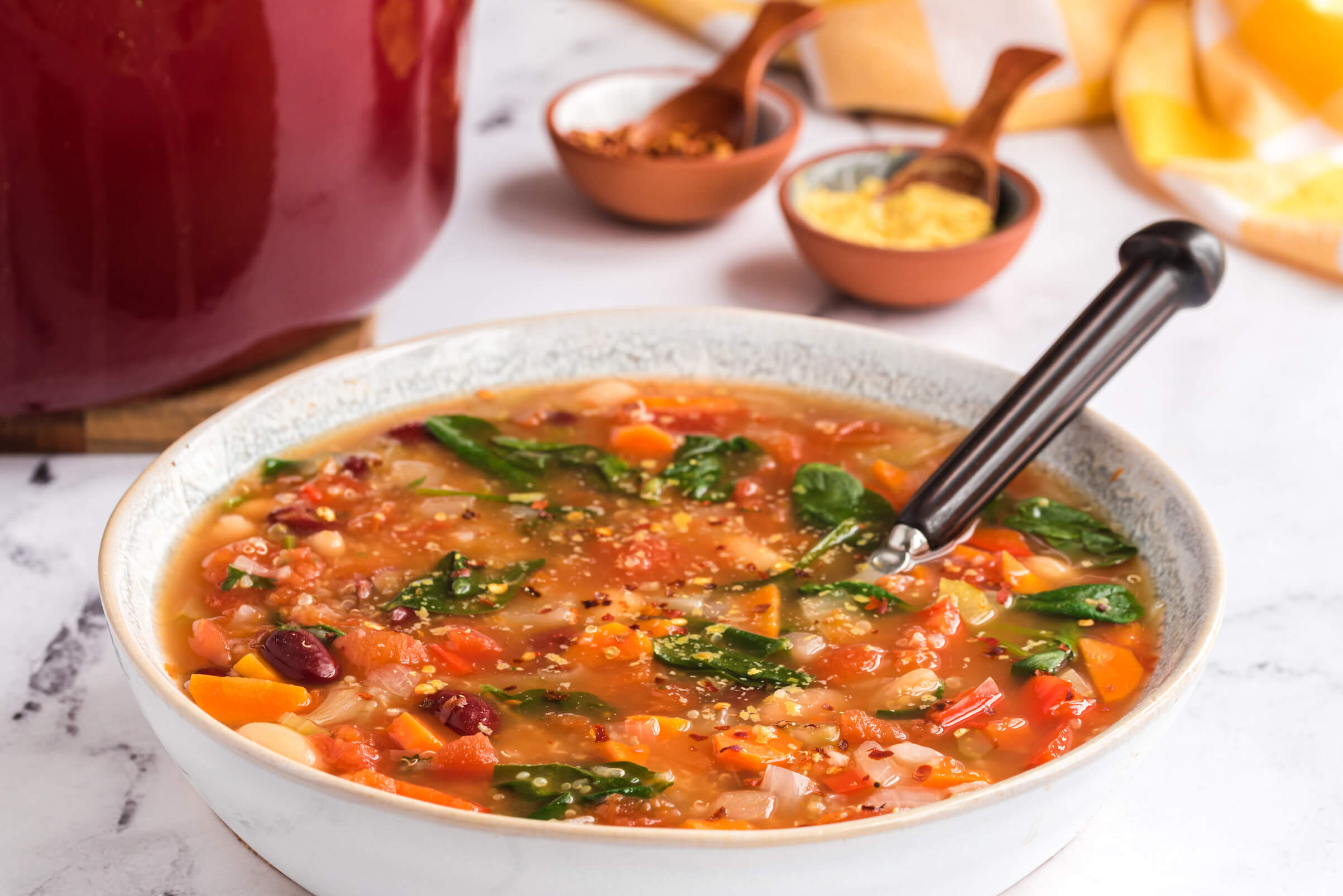
Yellow onion, red bell pepper, orange carrots, and green spinach add to the rainbow of colors in this comforting and satisfying soup. If you truly want to fulfill all of the colors of the rainbow then swap out either the kidney or white beans for black beans (which are actually purple!) and add organic blue corn to the veggie mix. If you want to wow your family and friends through a colorful table then serve this soup at your next dinner party!
Thai Peanut Rainbow Noodles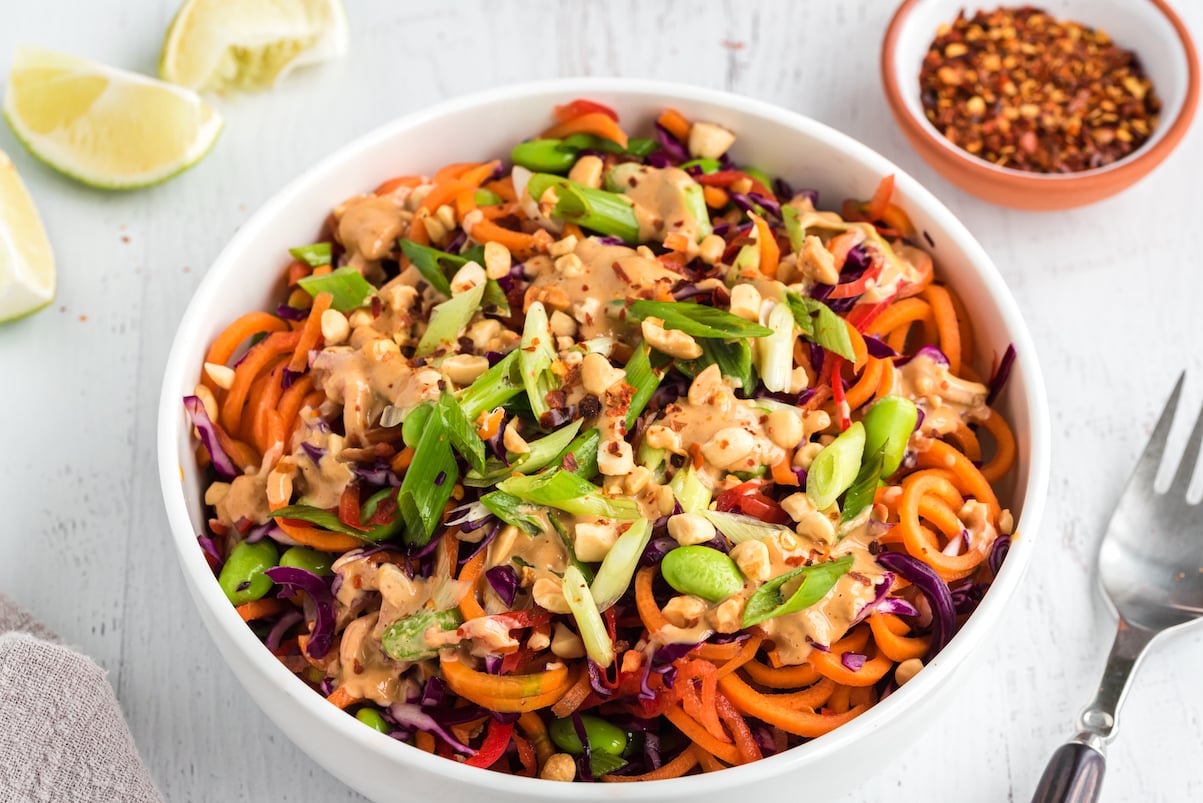
Raw, colorful veggie noodles bring this dish to life. What’s more, it can add vitality to your life when you enjoy its nutrient-dense, health-building ingredients! Enjoy the crunch, savor the flavor, and observe all the beauty that plant-based foods offer.
Autumn Sunrise Smoothie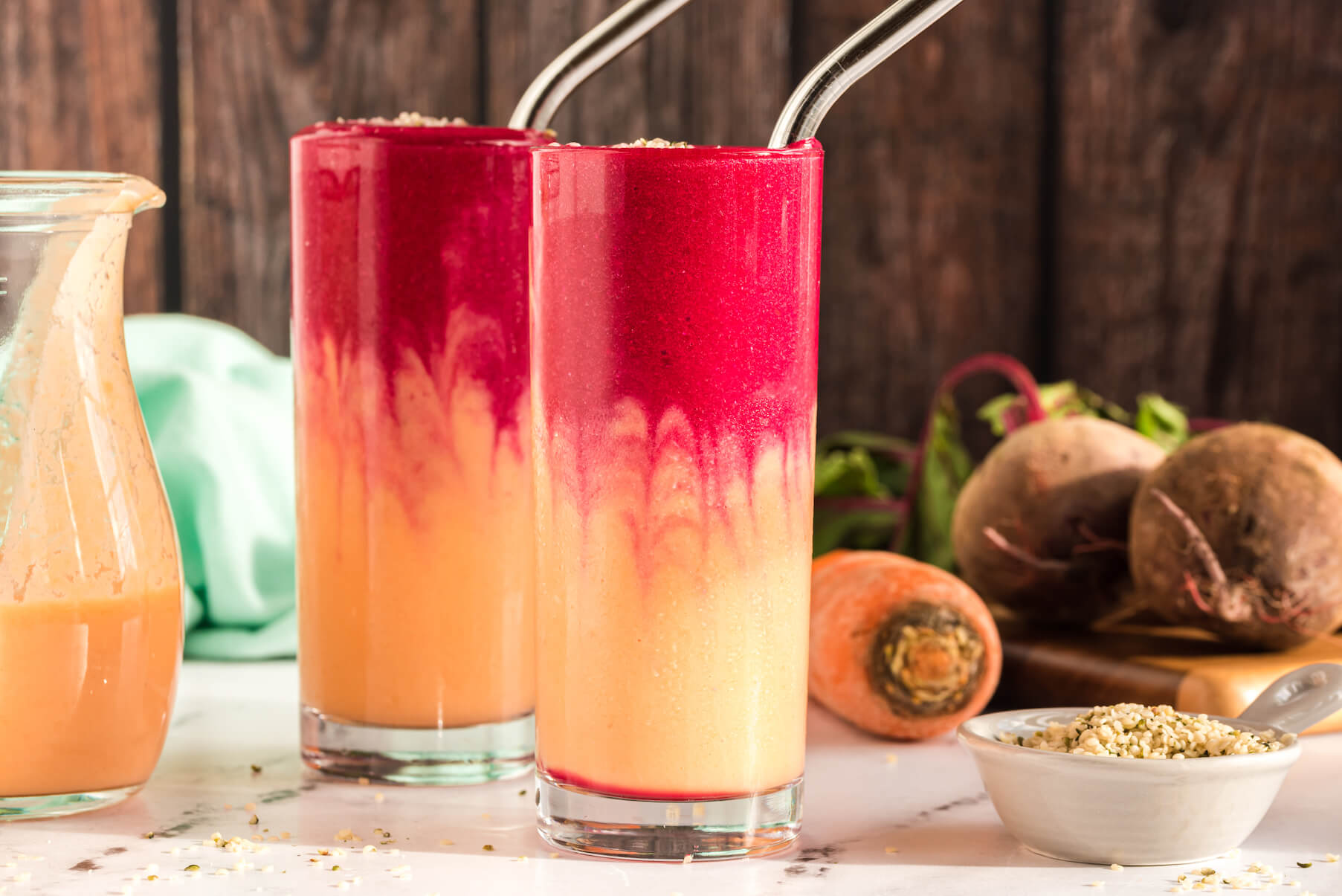
While this smoothie may not be exactly like a rainbow, it certainly looks like a pretty sunrise! Beets, pomegranate, and blood orange give it a beautiful purple-red hue while pineapple, mango, and carrot give it a stunning orange-yellow hue. Stir in a handful of blended blueberries and leafy greens to see all colors of the rainbow in one tasty smoothie. And, if you do, please snap a photo and share it with us!
How to Learn to Love Vegetables and Fruits
If you grew up eating only a few fruits and vegetables, you might not have developed an appreciation for produce. But don’t worry. You can retrain your taste buds to love broccoli, kale, and beets!
Here’s what you can do for yourself and your kids:
Step 1: Avoid processed food with lots of meat, cheese, salt, sugar, and fat. These foods overstimulate your taste buds and put you into the Pleasure Trap, making fresh fruits and vegetables taste boring in comparison.
Step 2: Try new vegetables and fruits over and over again in different ways. It can take 12–18 tastes to acquire a taste for new food. So, if you once hated arugula or mushrooms, that’s OK. Try again in a different recipe. You might surprise yourself.







